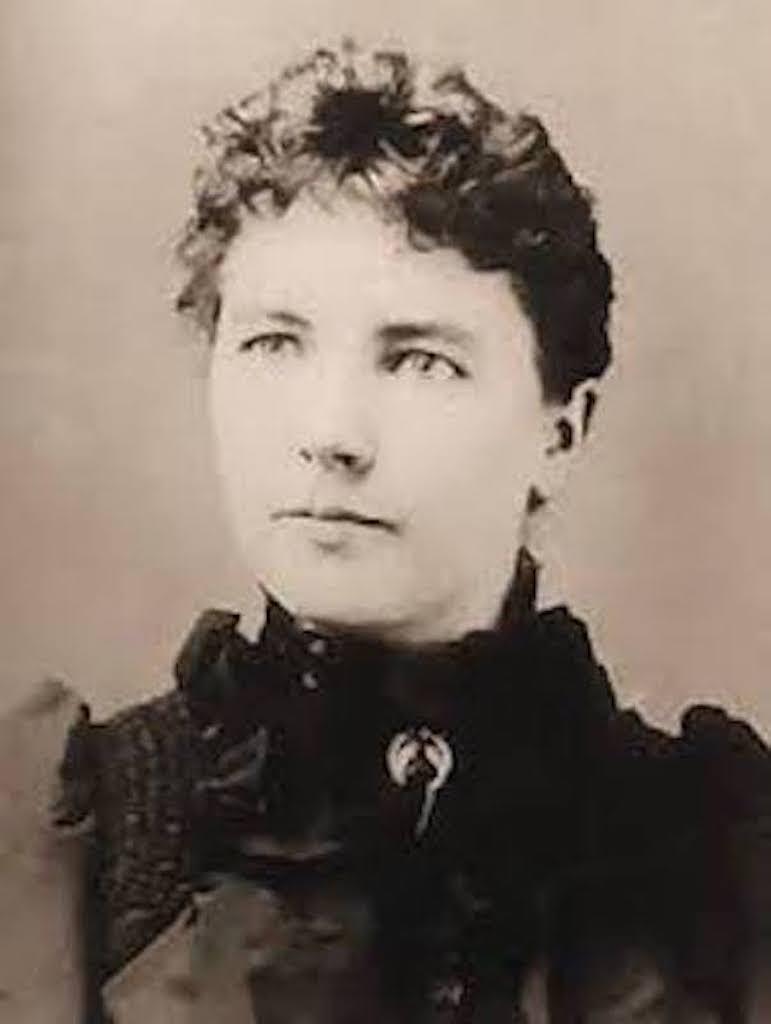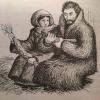The Little House on the Prairie books are based on Wilder's childhood on the American frontier and follow the fictionalized Ingalls family as they move from Missouri to Kansas to Wisconsin. Her stories provide a rich and compelling contrast to the Victorian ideals of the late 19th century and instead embrace the romanticization of the frontier. Her narrative strays far from the time's notions of ideal girlhood as the Ingalls faced adventures and battles for survival, effectively establishing the piece as a turning point in gender neutral literature and marking a transition to the entertaining text. While Christian traditions and values affected Wilder's upbringing, she abandoned the lessons of didactic literature in favor of sharing her own adventures for the entertainment of children.
Photo of Laura Ingalls Wilder, circa 1885, Wikipedia.
Laura Ingalls Wilder was born in Wisconsin in 1867, and she published the first book in the series, Little House on the Prairie, in 1935, making a name for herself in American literature. The family dealt with intense poverty, eviction, crop failure, and disease, but Wilder's fictional version in some ways glosses over the realities of her traumatic childhood, often focusing instead on the love and closeness of the family that fought to keep itself afloat. The adventures and obstacles she encountered provide the basis for a semi-autobiographical novel that breaks from the strict binaries of gender-specific literature. Additionally, she refuses to portray the struggles of her and her family as divine punishment. Instead, she exalts human strength in the face of hardship, standing in direct contrast to the didactic literary traditions she herself grew up with and establishing her works as entertaining texts.
Helen Sewell and Mildred Boyle,cover for By the Shores of Silver Lake (1939), by Laura Ingalls Wilder, 1953 edition.
This 1953 book cover depicts protagonist Laura staring in wonder at the nature around her at the Silver Lake, referred to in the title. Wilder's depiction is a departure from didactic texts such as Mary Martha Sherwood’s The Fairchild Family (1847) that preaches domesticity by alluding to eating the forbidden fruit in the Book of Genesis, using Eve’s original sin to condemn women as well as natural curiosity. Later entertaining texts such as L.M. Montgomery’s Anne of Green Gables (1908) allow for a connection between women and nature, but it is a decidedly romantic and feminine one. In contrast, Wilder has her female protagonist interact with nature in an adventurous, traditionally masculine way, by getting lost in it, encountering wild animals such as wolves and panthers, and performing male jobs such as twisting the hay. Essentially, Laura is connected with the land the same way her father is. She is eager to explore this wilderness that has become her ever-changing home as the Ingalls family moves across the country; Laura says, “‘Oh, Pa, let’s go on West!” and she is not punished for her curiosity. Laura’s enthusiasm mirrors Pa’s desire for continued adventure and movement, reminiscent of the dominant dream of American men at that time, and Pa tells her, “‘I know, half-pint… you and I want to fly like the birds.’” The wilderness is theirs for the taking and for the taming.
Garth Williams, "Digging out the Train," for The Long Winter (1940), by Laura Ingalls Wilder, 1953 edition.
This signed illustration by Garth Williams depicts the perilous struggles of the winter of 1880. The common thread of didactic literature was the imparting of strict Christian morals and instilling in children a fear of God. This is best exemplified in James Janeway’s A Token for Children (1672) or Mary Martha Sherwood’s “The All-Seeing God” and "Sad Story of a Disobedient Child" (1847). In these texts, children meet violent ends, burning to death for their vanity or disobedience and being painfully punished for their innate sinfulness. In turn, Laura sees God not as a punisher, but as a protector. The Long Winter (1940) follows the severe winter of 1880, and in a didactic context, the severity of this storm would be portrayed as a punishment for the sins of the family or the children. Instead, Laura’s connection with the wilderness allows her to accept both the beauty and the harshness of nature. When Laura is scared, she is forced to question the role of God, saying, “‘I thought God was supposed to take care of us.’” This interrogation demonstrates a uniquely modern American perspective. Pa responds by saying, “‘He does… so far as we do what’s right. And He gives us a conscience and brains to know what’s right. But He leaves it to us to do as we please.’” This lesson would never have made it to the pages of Janeway and Sherwood. This belief demonstrates mid-19th century American values of independence and self-sufficiency, but in the didactic mind, such messages would be blasphemous and sinful.
Garth Williams, "Laura and Pa Twisting Hay," for The Long Winter (1940), by Laura Ingalls Wilder, 1953 edition.
This image of Laura and Pa twisting hay together during the long winter is demonstrative of a deviation from gender specific literature. Wilder’s novel The Long Winter is the sixth in the series, retelling the harrowing 1880 winter in Dakota territory. Victorian culture enforced strict binaries when it came to the role each gender played culturally and in the home. L.M. Montgomery’s Anne of Green Gables (1908) is a beloved example of gender-specific literature for girls where traditional femininity is praised and rewarded. In contrast, Robert Louis Stevenson’s Treasure Island (1883) was marketed towards boys, telling a tale of survival and adventure, presented as exclusively masculine. The difficulties the Ingalls encountered brought such perceptions under scrutiny. When the blizzards come during that 1880 winter, they beat on for seven months, and the family fights off starvation and is eventually forced to twist hay into kindling when they run out of coal. Laura is eager to escape the domesticity she feels is thrust upon her, and she jumps at the chance to help Pa with a chore traditionally for boys. Yet it is not Pa’s strength that got them through the winter, but rather Ma’s domestic wisdom and ingenuity. Pa’s fuel eventually runs out, and the family uses up their wheat, but Ma’s ability to turn nothing into something is miraculous. While the girls help, Ma is able to turn Pa’s measly harvest into cans and jars full of pickles and jams, making the inedible into something that can sustain her family. Although Ingalls reveals the struggles she had with her own sense of femininity, she also shows us that her resentment does not come from a place of disdain. Ma’s femininity and domesticity are their saving grace, and by embracing society’s ideals of womanhood, Ma indeed establishes her own strength. Therefore, instead of marketing her writing to one gender or the other, Wilder finds common ground. She shows female characters taking on male roles and praises Pa's role as a provider, but she also demonstrates an incredible strength in womanhood, connecting aspects of books for boys and girls.





